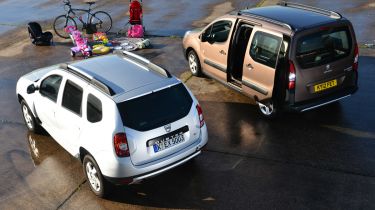Dacia Duster vs Peugeot Partner Tepee
Practical van-based MPV provides a different challenge
Take a look at the Dacia website and you’ll see lots of talk about ‘function over frivolity’. But the idea of a car that offers basic, robust, no-frills motoring is nothing new.
The best example of this approach is the van-based MPV. The Peugeot Partner Tepee doesn’t look as distinctive as the Duster, with its slab sides and high roof, but the van-based body means you get lots of space.
Sliding doors make cabin access easy in tight spaces, while huge windows let in lots of light. There’s headroom to spare, and the Peugeot has a longer wheelbase than the Duster, so there’s lots of legroom. The top-of-the-range Outdoor has three individual chairs, but our S version has a 60:40 split-folding bench.
There’s no beating the Tepee when it comes to carrying stuff, though. The 675-litre boot is 200 litres bigger than the Dacia’s, while a full-width overhead storage shelf is another handy feature van drivers would recognise.
Like the Duster, the cabin is pretty basic. S models get a carpeted boot, a fully trimmed interior and a height-adjustable driver’s seat. Once you’re seated, the flat-angled pedals, inclined wheel and raised seating position are more signs of its van heritage.
Used - available now

2022 Dacia
Duster
9,260 milesManualPetrol1.0L
Cash £13,592
2017 Dacia
Duster
49,163 milesManualDiesel1.5L
Cash £8,500
2020 Dacia
Duster
60,148 milesManualPetrol1.3L
Cash £9,906
2017 Dacia
Duster
73,300 milesManualDiesel1.5L
Cash £6,744Still, it’s pretty comfortable, and the simple dash layout is easy to get on with. There are no frills, but everything is well screwed together, and with chunkier doors and better gaps in the trim plastics, the Peugeot doesn’t feel quite as basic as the Duster does.
On the move, the Tepee’s large windscreen gives a commanding view of the road, and the car is surprisingly relaxing to drive. It’s fairly smooth on the motorway and there’s less road noise than in the Duster, but its high centre of gravity means it’s more unwieldy in corners, plus the steering is a little slow.
However, the tyres hang on well before giving up grip, and this helped the Peugeot record better braking figures than the Duster. Overall, the Partner is reassuring to drive, although it doesn’t have stability control – a £600 option with curtain airbags.
Our performance figures are for the more expensive 113bhp Outdoor model, but if you want to match the Duster’s low price, you have to stick to the 75bhp S version. With just 185Nm of torque, it’s going to struggle when empty and feel very lethargic when it’s filled. The 1.6-litre HDi turbodiesel is quite noisy, too, but as with the Duster’s 1.5-litre diesel, it’s perfectly acceptable.
The Peugeot emits 139g/km, so it sits one company car tax band higher than the Duster, but we averaged 41.6mpg – just pipping the Dacia’s 39.8mpg. Amazingly for a car brand that’s just establishing itself, the Dacia is predicted to hold on to more of its value than the Tepee, plus Peugeot’s one-year recovery deal is a little measly.
You can get fixed-price servicing for the Partner, but when you’re buying a bargain car, small running costs and price differences are important, so the Dacia’s near-£1,000 lower list price gives it a clear advantage.







